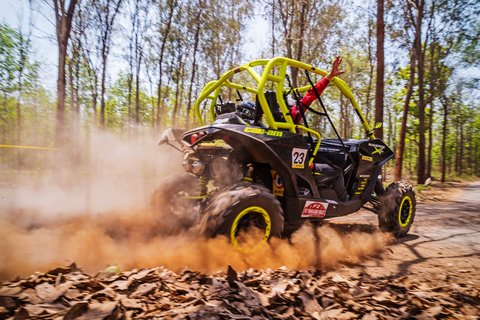For too many four-wheel enthusiasts, the fear of rolling a new UTV often turns into the reality of doing so. While the hardy off-road vehicles can take a beating, the human body cannot.
While UTVs are often much more safer than ATVs — they account for a few hundred deaths since 2003 versus ATVs which contribute to around 800 deaths per year — UTVs still come with a set of dangers.
There are a few obvious rollover concerns that you can spot with a glance. Most notably are the narrow track width and high center of gravity present in most machines. Put simply and in auto industry terms, a Dodge Sprinter will probably roll in conditions that a Chevrolet Corvette won’t.
But all is not translatable to autos, nor noticeable at a glance. Severe under-steering to severe over-steering causes sluggish response followed by violent snap. By the time the driver learns about this issue, it is probably too late.
To better understand, let’s divide the rollover problem into two categories: performance rollovers and utility rollovers. For the sake of differentiation, we will say a performance rollover occurs when pushing a UTV to the limit and rolling at speed. Utility rollovers will refer to those instances when riding cautiously and losing control of the situation.
To put it simply, performance rollovers can be addressed by not pushing such large machines to their limits. The logic lies within the name Utility Terrain Vehicle. It’s not a “Performance” Terrain Vehicle. If you want to push a machine built for work, then you accept the possibility of accident.
On the other hand, there is another obscure but accepted name for these vehicles: ROVs, or Recreational Off-highway Vehicle. It would be wrong to assume people won’t push all combustion-powered machines to their limits, as is evidenced by the existence of tractor drag racing.
In the modification department, you can add a door, but that’s only going to protect your legs in the instance of an accident and not the accident itself. On the topic of additions, a roll cage is an extreme but often life-saving measure you can go to.
In the occurrence of a rollover, do not attempt to stop the accident by putting your arms or legs outside the vehicle. Several hundred pounds of steel, kinetic energy and the unforgiving nature of the ground will work together to win in a fight against human bone.
Utility accidents, especially rollovers, can be a big issue because they often involve cargo being carried or towed and drivers who don’t want to lose that cargo. Any added weight in a cargo container or trailed behind will change the behavior of suspension.
Fortunately, loads in the cargo container can help stabilize the UTV, but it will also add stress on the suspension, so avoid excessive speed over bad terrain. Really, any UTV used for work should see little intentional suspension abuse, because many models are equipped with just enough to get you by.
UTVs are more equipped for bumps than golf carts, but that doesn’t mean you should put them through the Baja 1000 gauntlet. Hitting a big bump at speed can cause an uneven return to to the ground, and subpar suspension could react with a rollover. You don’t want to roll over, and you don’t want to be hit in the head with a log during the roll, so stay level when carrying loads.
While UTVs can provide for a good time, especially to those who live in areas where they can be used outside the property line for transportation, it is important to consider that being thrown from one can result in being crushed or other serious injury. While it may seem like an afterthought, wearing your seatbelt can prevent a hospital visit from becoming a hospital stay.
Photo credit: Dreamstime








